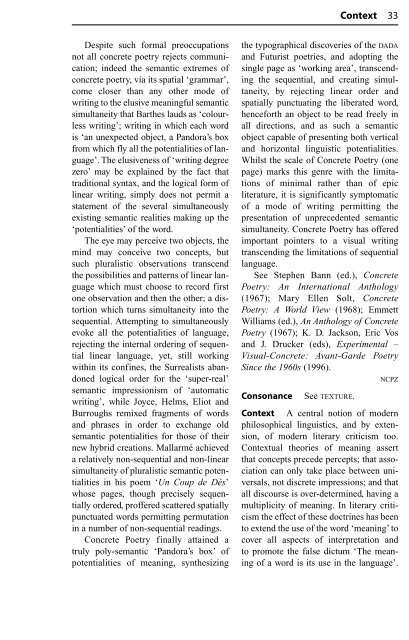The Routledge Dictionary of Literary Terms
The Routledge Dictionary of Literary Terms
The Routledge Dictionary of Literary Terms
Create successful ePaper yourself
Turn your PDF publications into a flip-book with our unique Google optimized e-Paper software.
Despite such formal preoccupations<br />
not all concrete poetry rejects communication;<br />
indeed the semantic extremes <strong>of</strong><br />
concrete poetry, via its spatial ‘grammar’,<br />
come closer than any other mode <strong>of</strong><br />
writing to the elusive meaningful semantic<br />
simultaneity that Barthes lauds as ‘colourless<br />
writing’; writing in which each word<br />
is ‘an unexpected object, a Pandora’s box<br />
from which fly all the potentialities <strong>of</strong> language’.<br />
<strong>The</strong> elusiveness <strong>of</strong> ‘writing degree<br />
zero’ may be explained by the fact that<br />
traditional syntax, and the logical form <strong>of</strong><br />
linear writing, simply does not permit a<br />
statement <strong>of</strong> the several simultaneously<br />
existing semantic realities making up the<br />
‘potentialities’ <strong>of</strong> the word.<br />
<strong>The</strong> eye may perceive two objects, the<br />
mind may conceive two concepts, but<br />
such pluralistic observations transcend<br />
the possibilities and patterns <strong>of</strong> linear language<br />
which must choose to record first<br />
one observation and then the other; a distortion<br />
which turns simultaneity into the<br />
sequential. Attempting to simultaneously<br />
evoke all the potentialities <strong>of</strong> language,<br />
rejecting the internal ordering <strong>of</strong> sequential<br />
linear language, yet, still working<br />
within its confines, the Surrealists abandoned<br />
logical order for the ‘super-real’<br />
semantic impressionism <strong>of</strong> ‘automatic<br />
writing’, while Joyce, Helms, Eliot and<br />
Burroughs remixed fragments <strong>of</strong> words<br />
and phrases in order to exchange old<br />
semantic potentialities for those <strong>of</strong> their<br />
new hybrid creations. Mallarmé achieved<br />
a relatively non-sequential and non-linear<br />
simultaneity <strong>of</strong> pluralistic semantic potentialities<br />
in his poem ‘Un Coup de Dés’<br />
whose pages, though precisely sequentially<br />
ordered, pr<strong>of</strong>fered scattered spatially<br />
punctuated words permitting permutation<br />
in a number <strong>of</strong> non-sequential readings.<br />
Concrete Poetry finally attained a<br />
truly poly-semantic ‘Pandora’s box’ <strong>of</strong><br />
potentialities <strong>of</strong> meaning, synthesizing<br />
Context 33<br />
the typographical discoveries <strong>of</strong> the DADA<br />
and Futurist poetries, and adopting the<br />
single page as ‘working area’, transcending<br />
the sequential, and creating simultaneity,<br />
by rejecting linear order and<br />
spatially punctuating the liberated word,<br />
henceforth an object to be read freely in<br />
all directions, and as such a semantic<br />
object capable <strong>of</strong> presenting both vertical<br />
and horizontal linguistic potentialities.<br />
Whilst the scale <strong>of</strong> Concrete Poetry (one<br />
page) marks this genre with the limitations<br />
<strong>of</strong> minimal rather than <strong>of</strong> epic<br />
literature, it is significantly symptomatic<br />
<strong>of</strong> a mode <strong>of</strong> writing permitting the<br />
presentation <strong>of</strong> unprecedented semantic<br />
simultaneity. Concrete Poetry has <strong>of</strong>fered<br />
important pointers to a visual writing<br />
transcending the limitations <strong>of</strong> sequential<br />
language.<br />
See Stephen Bann (ed.), Concrete<br />
Poetry: An International Anthology<br />
(1967); Mary Ellen Solt, Concrete<br />
Poetry: A World View (1968); Emmett<br />
Williams (ed.), An Anthology <strong>of</strong> Concrete<br />
Poetry (1967); K. D. Jackson, Eric Vos<br />
and J. Drucker (eds), Experimental –<br />
Visual-Concrete: Avant-Garde Poetry<br />
Since the 1960s (1996).<br />
NCPZ<br />
Consonance See TEXTURE.<br />
Context A central notion <strong>of</strong> modern<br />
philosophical linguistics, and by extension,<br />
<strong>of</strong> modern literary criticism too.<br />
Contextual theories <strong>of</strong> meaning assert<br />
that concepts precede percepts; that association<br />
can only take place between universals,<br />
not discrete impressions; and that<br />
all discourse is over-determined, having a<br />
multiplicity <strong>of</strong> meaning. In literary criticism<br />
the effect <strong>of</strong> these doctrines has been<br />
to extend the use <strong>of</strong> the word ‘meaning’ to<br />
cover all aspects <strong>of</strong> interpretation and<br />
to promote the false dictum ‘<strong>The</strong> meaning<br />
<strong>of</strong> a word is its use in the language’.

















